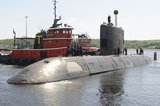Germany fires shipboard laser weapon for the first time
High-energy laser weapons for navies are especially useful for defending against drones, swarms and small boats at close ranges. (Photo: MBDA)
On 30 August, the German F124 frigate Sachsen engaged drones at short and very short ranges with a laser weapon in a first for the German Armed Forces.
The weapon used in the test was developed by the country’s High-Energy Laser Naval Demonstrator working committee, AGRE, comprising MBDA Deutschland and Rheinmetall Waffe Munition.
Integration and testing of the laser weapon demonstrator began in late 2021. The system was then later installed on board the Sachsen in Kiel.
The trial verified the capability of sensors, including an EO suite and radar. Operational testing included multiple highly realistic engagement scenarios.
Germany will continue to test the high-energy laser weapon into mid-2023. The results of this further testing will help determine the pathway to a fully-functional operational laser weapon.
More from Naval Warfare
-
![Maritime defence in the Mediterranean faces challenges from vulnerable land power]()
Maritime defence in the Mediterranean faces challenges from vulnerable land power
As an indispensable energy crossroads, the Mediterranean is at serious risk from grey zone disruption. As navies increasingly employ AI data centres, what happens when cutting-edge defence technologies rely on the very infrastructure most susceptible to hybrid tactics?
-
![US Navy to conduct an experimentation campaign with emerging tech in 2026 and 2027]()
US Navy to conduct an experimentation campaign with emerging tech in 2026 and 2027
The Technology Operational Experimentation Events will inform future requirements as the US Navy looks for innovative solutions across three key operational domains.
-
![Future Canadian Continental Defence Corvette will provide “Halifax-equivalent capabilities”]()
Future Canadian Continental Defence Corvette will provide “Halifax-equivalent capabilities”
Although the CDC project is still in its early stages, the Canadian Department of National Defence already has some requirements for the future platforms.





















